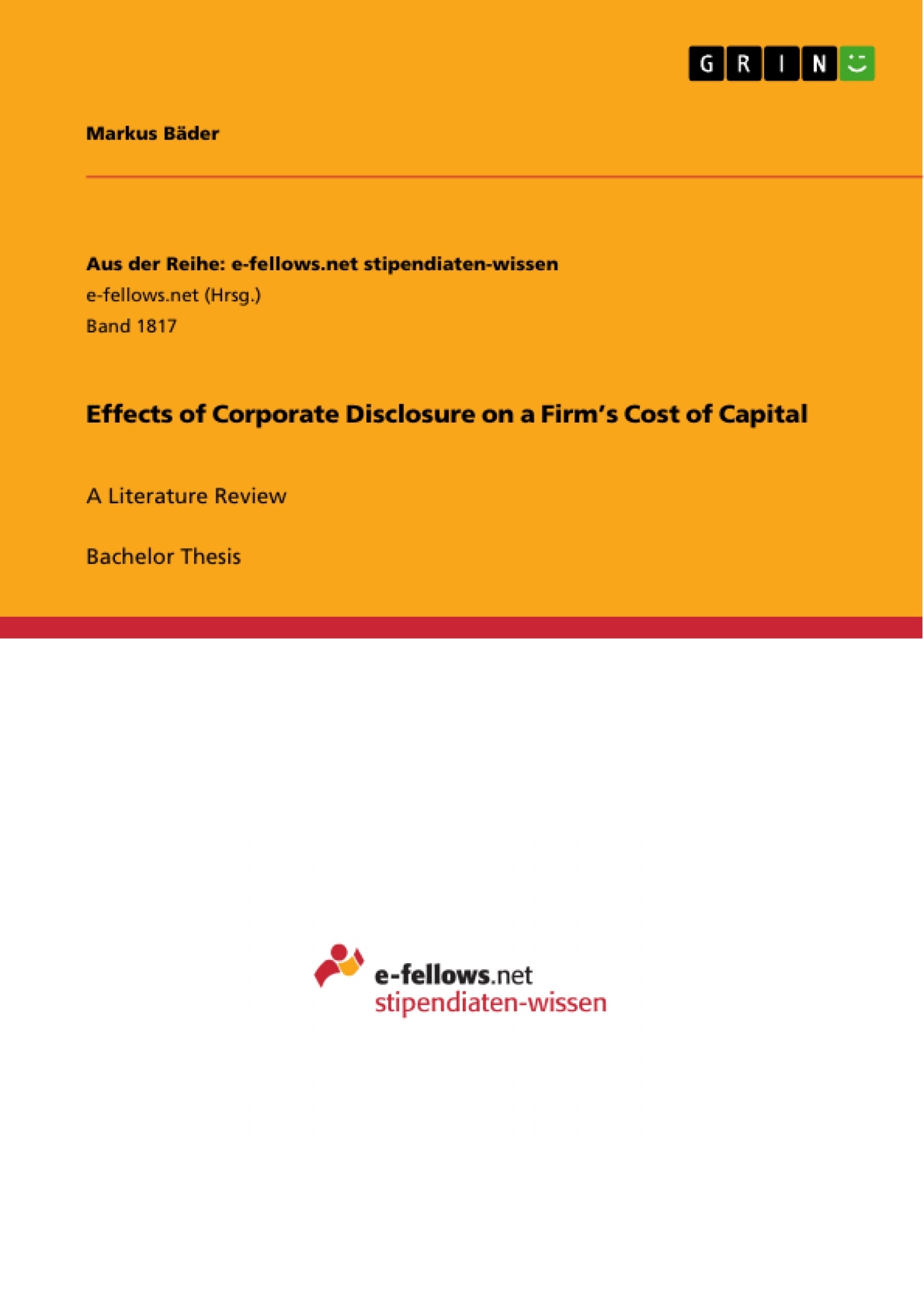The potential relation of increased levels of corporate disclosure on a firm’s cost of capital remains of great importance, both from a research-focussed and business- oriented point-of-view; however, the existence of methodological drawbacks has led to ever more complex studies, which eventually made the literature vast and confusing for outside readers. The purpose of this thesis was to organise and thereby simplify the different perspectives on a dynamic issue.
It is argued that, in theory, enhanced transparency levels the marketplace by spreading information more equally among investors. Consequently, the information asymmetry component is mitigated, which translates into lower levels of estimation risk, transaction costs and default risk. After all, theoretical studies provided evidence that increased disclosure lowers the costs of capital.
However, since neither of the involved components is directly observable, a myriad of approaches emerged to approximate actual figures. Although most of these proxies follow similar patterns, it is argued that none of the present approaches is free from constraints, which, in turn, affects the reliability of existing empirical studies. Research, after all, still lacks a generally accepted and holistic approach to the present day. In this context, one of the most recent findings provides a new and rather praxis-oriented perspective, by arguing that firms and investors are merely interested in a good-practice level of disclosure.
Regardless of the perspective, an ultimate conclusion has yet to be revealed by the literature and it seems illusory that academics and practitioners agree on one approach in the future. Nevertheless, the contribution of this thesis was merely to structure and simplify the current state of a dynamic issue. The author therefore used easy to understand graphics and tables and linked the findings to related fields of research, where necessary.
Inhaltsverzeichnis (Table of Contents)
- Introduction
- Rationale for this Thesis
- Academic Objectives
- Setting the Scene
- Outline and Structure
- Relevance and Components of the Costs of Capital
- Costs of Equity Capital
- Costs of Debt Capital
- Causal Link between Disclosure and Costs of Capital
- Disclosure in General
- Disclosure to Reduce Costs of Equity
- Disclosure to Reduce Estimation Risk
- Disclosure to Reduce Transaction Costs
- Disclosure to Reduce Costs of Debt
- Methodological Measuring Approaches
- Measuring Disclosure
- Measuring Costs of Equity
- Measuring Priced Risk
- Asset Pricing Approach
- Dividend Discount Approach
- Measuring Information Asymmetry
- Bid-Ask Spread Approach
- Trading Volume Approach
- Share Price Volatility Approach
- Measuring Priced Risk
- Measuring Costs of Debt
- Legitimate Aspects of Empirical Studies
- Empirical Evidence for the Impact of Disclosure on Costs of Capital
- Discussion of Existing Studies
- Priced Risk Studies
- Information Asymmetry Studies
- Hybrid Studies
- Focused Studies
- Contradicting Results
- Self-Selection Bias
- Correlation Issues
- Calculation Issues
- Good-Practice Level
- Discussion of Existing Studies
- Conclusion
- Further Research
- Discussion
Zielsetzung und Themenschwerpunkte (Objectives and Key Themes)
This thesis aims to investigate the causal link between corporate disclosure and the costs of capital. It examines how disclosure affects both the cost of equity and the cost of debt. The study explores the theoretical framework and empirical evidence surrounding this relationship. * **The impact of disclosure on the cost of capital:** This theme examines how different types of disclosure, such as financial information, corporate governance practices, and environmental, social, and governance (ESG) factors, influence the cost of equity and debt. * **Measuring disclosure and costs of capital:** The study explores various methods for measuring disclosure levels and the costs of capital, including asset pricing models, information asymmetry measures, and bid-ask spreads. * **Empirical evidence and contradicting results:** The thesis analyzes existing empirical studies on the relationship between disclosure and costs of capital, highlighting both supporting and contradicting findings. * **Factors influencing the relationship:** The study investigates factors that can influence the relationship between disclosure and costs of capital, such as self-selection bias, correlation issues, and the level of good practice disclosure. * **Implications for corporate practice and policy:** The findings provide insights into the importance of disclosure for reducing costs of capital and informing corporate decision-making.Zusammenfassung der Kapitel (Chapter Summaries)
The introduction provides the rationale for the thesis, outlining the academic objectives and setting the scene for the research. It also presents the structure and organization of the study. Chapter 2 discusses the relevance and components of the costs of capital, focusing on the costs of equity capital and the costs of debt capital. It explores the factors that influence these costs and their implications for corporate decision-making. Chapter 3 delves into the causal link between disclosure and the costs of capital. It examines how disclosure can reduce both the costs of equity and the costs of debt by reducing estimation risk, transaction costs, and default risk. Chapter 4 presents the methodological approaches used to measure disclosure and costs of capital. It discusses different techniques for measuring disclosure levels, such as content analysis and accounting ratios, and various methods for calculating the costs of equity and debt, including asset pricing models and information asymmetry measures. Chapter 5 analyzes existing empirical evidence for the impact of disclosure on the costs of capital. It reviews studies that have investigated this relationship, highlighting both supporting and contradicting findings. The chapter also discusses potential biases and methodological challenges in empirical research.Schlüsselwörter (Keywords)
The key focus of this thesis is on the relationship between disclosure and the costs of capital. This involves exploring various aspects of disclosure, including financial reporting, corporate governance, and ESG factors. The research also delves into the methods for measuring disclosure and costs of capital, such as asset pricing models, information asymmetry measures, and empirical studies.- Citar trabajo
- Markus Bäder (Autor), 2015, Effects of Corporate Disclosure on a Firm’s Cost of Capital, Múnich, GRIN Verlag, https://www.grin.com/document/323353



